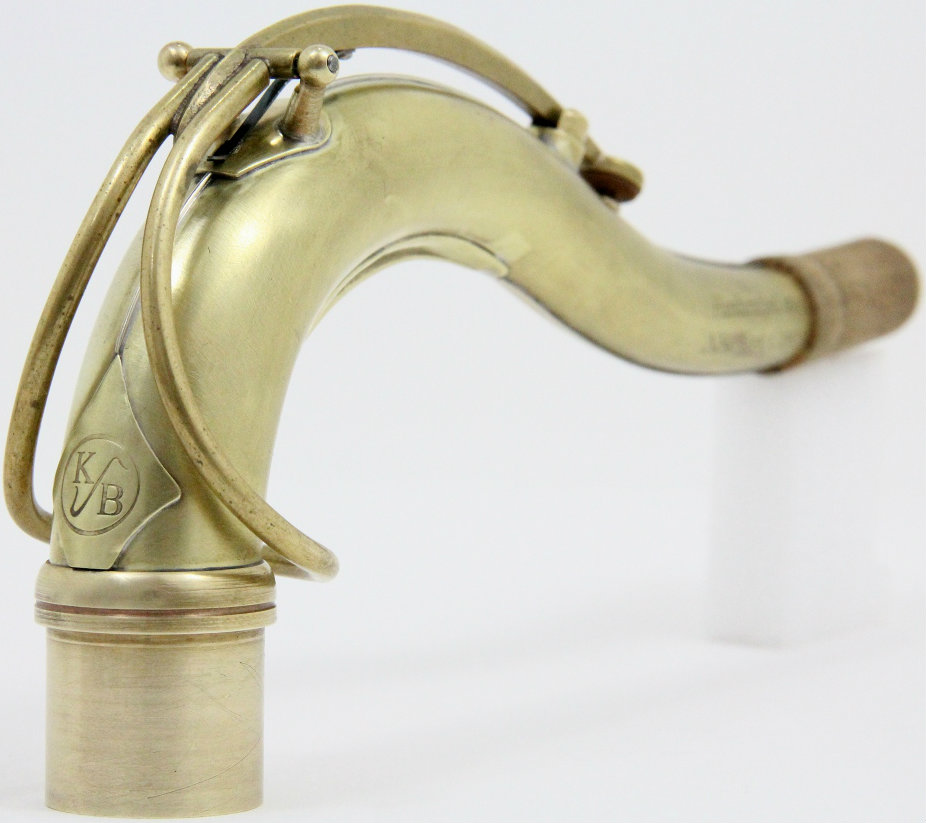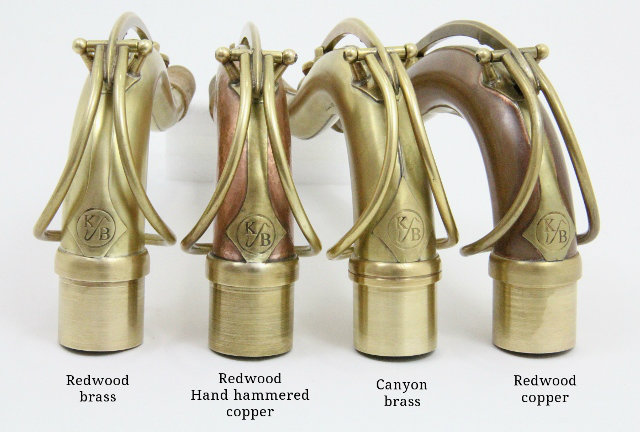KB Saxophone Necks – Gimmick or Game Changer?
KB Sax Handcrafted Saxophone Necks

Introduction
I visited Kim Bock’s shop a few years ago to try out various vintage Selmer and TM custom saxophones as well as gain a better understanding of his repair work since more and more players were going to Kim to have their saxophones overhauled and setup. Recently, Kim has introduced his own line of saxophone necks which of all the saxophone accessories on the market today, (mouthpieces, ligatures, reeds, neck-straps, screws, etc.) there are only a few saxophone neck manufacturers such as: Oleg, Gloger, Paraschos, Warburton, DaCarbo, and Tino Schuct. Since I have not experimented much with saxophone necks, (mainly saxophones, mouthpieces, reeds, neckstraps and ligatures) I was interested in finding out more information about these necks. Kim was nice enough to send me the Redwood and Canyon brass neck which I will be providing a product overview as well as my overall thoughts on each neck.
Product Overview
Kim designed the KB saxophone necks around the resonance, tonal color, and flexibility of the legendary and highly sought after Selmer Super Balanced Action and the early Mark VI saxophones. Each one of Kim Bock’s necks are 100% handcrafted in his shop and are custom fit to a large selection of vintage and modern saxophones. Kim developed and perfected his necks with the feedback from many professional saxophonists from around the world throughout a 1 ½ year prototype period. Throughout this process, Kim recognized the saxophone neck as having the greatest impact on the instruments performance over any other part of the horn. The neck is where most of the sound color, intonation, tonal feel and flexibility are created. Kim has found that by using one of his KB handcrafted saxophone necks, the player will notice a better performance on both modern and vintage horns.
Neck Making Process
The KB saxophone necks are unique to the standard neck making process. How a traditional saxophone neck is made is by “forming a metal sheet around a mandrel to create a conical tube. The tube is then bent over a form to give it the specific shape of a saxophone neck. Some parts of the metal are stretched much more than others during this process which results in a neck with varying wall thickness.” The KB sax necks are made by first stamping out the two halves/sides of the neck and then silver soldering them together to create the neck tube. This results in a neck tube with a much more uniform wall thickness throughout. Kim believes this is part of the reason why his necks sound and feel so resonant compared to other necks on the market. By making each neck by hand, Kim is able to maintain tolerances of +/- 0.002” (thousands of an inch) throughout production which ensures a much higher level of consistency in quality and sound.
Neck Models

Currently Kim offers two models which are the Redwood and Canyon. The Redwood model does come in copper as well as hand hammered copper while the Canyon model is currently offered in just brass. Below is a description of each model.
Redwood
“The brass Redwood is the most focused of our necks with a dark and round core sound. Your air is channeled into a tight yet robust tone-feel that makes the horn feel quick and compact in the lower range while maintaining the strong and present core sound without changing character as you move through the palm keys and up throughout the altissimo range. It has a hint more resistance than the Redwood copper variations but also stays incredibly centered and round when you really push it.While it is quite focused it maintains great tonal flexibility and a deep complexity to the sound.”
Redwood Copper
“The copper Redwood has a wider, warmer and slightly more free blowing character than its brass equivalent. The sound is a little less mid-tone concentrated and the frequency spread is a more pronounced, punctuated with more highs and lows.It is a softer alloy, so it is more susceptible to damage. Assembling your horn by first putting the mouthpiece on the neck followed by putting the neck on the horn will help prevent neck pull-down. This model has toured the world with pro players and has sustained no damage when cared for responsibly.”
Redwood Hand Hammered Copper
“Hand hammering our copper neck serves two purposes: Firstly, this work hardens the copper, making it less prone to pull-down damage compared to the copper neck. In fact, the hand hammered copper is as strong as brass. Secondly, it gives the neck a unique set of sound characteristics. The tone is more focused than the regular copper neck. While it has an added brightness, it still maintains the flexible yet solid core tone of the Redwood family.”
Canyon
“The Canyon is inspired by the free blowing, full spectrum sound of Selmer’s early Mark VI. It features a wide and slightly spread sound with a deeply resonant tone feel. It is fast responding, has a rich tonal color with that certain “sizzle” or brilliance in the higher frequencies that sprays out in a way that sparkles when you lean into it.”
Review
Before you receive a KB saxophone neck, Kim will ship you tenon receiver measuring gauges. With these gauges, you will measure you model saxophone and provide Kim these measurements so he can make sure that when he sends you a neck, it properly fits your saxophone. In addition to using the tenon receiver measuring gauges, you could also contact your local repairman to get the measurements as well.
When I received the KB Redwood neck, I noticed no blemishes or inconsistencies throughout and the neck reminded me of a SBA style neck. When I began play testing the KB Redwood neck against a Lupifaro tenor neck, I noticed Kim’s description of the Redwood model is exactly what I found as well. The KB Redwood neck was more focused and bit darker than the Lupifaro neck. I found The Redwood neck to play consistent throughout the entire range of the saxophone from soft to loud and also found it very easy to articulate. I did find this neck had a bit more resistance or back-pressure than the Lupifaro neck but this is a characteristic many players who typically play vintage Selmer’s are looking for these days. Compared to the Redwood neck, the Canyon neck embodied the same characteristics as the Redwood but the Canyon neck was more free blowing and was inspired by the characteristics found in the early Mark VI’s. I found the extreme ranges of the horn were big and spread compared to the Redwood that was more focused.
Conclusion
The KB Redwood and Canyon saxophone neck was well constructed and reminded me of the feel and sound I find when playing an SBA or Mark VI. I have not experimented much with various necks due to the limited availability as well as finding a neck that properly fits my saxophone but after play testing one of Kim’s necks, I have now come to realize that experimenting with various necks can have a greater impact on the way the saxophone sounds and feels then I thought. I want to thank Kim for sending me his Redwood and Canyon model necks to test play. Since Kim’s handcrafted necks are $1,180+, I highly recommend going to KB saxophone services website to find out more about the 7 day trial period to see if you notice the difference. I hope this review was beneficial and I would appreciate it if you would leave any comments or questions.
Website
http://www.kbsax.com/kbsax-necks.html
KB Saxophone Neck YouTube Video
http://www.youtube.com/watch?v=mOqEO75DuUs






August 6, 2016 @ 2:36 pm
Recently Bought a new redwood brass neck at KBSax for a SM6. Changed the projection of the sax significantly. Love it.
May 11, 2018 @ 8:48 am
Thanks for this article.
January 12, 2020 @ 10:10 am
How much for a new neck for my Conn 10m S/N 993779 with a Berg Larsen 10 5
2
M
(The above is the way it’s marked on the mouth piece)
I”m assuming you know exactly how to fit it. Pleas let me know by email. Thanks!
January 12, 2020 @ 1:37 pm
Hey Joseph,
Here is the link with further pricing: http://www.kbsax.com/kbsax-necks.html#7-day_trial_period__free_shipping.
The KB necks range from $1,180-$1,280 depending on finish/material
If you email Kim, he can provide you further details on neck fitting as well as if needed, you could go to your trusted repair person to make sure the fit is proper but he will send you gauges so you can confirm the best possible size.
Email: info@kbsax.com
Tel: 212-683-2985
The mouthpiece will only matter in terms of how it fits on the cork. The good news is the cork if need can be easily sanded down to fit your mouthpiece or Kim and his team could further assist before sending.
Hope this helps!
Zach
June 16, 2023 @ 7:41 pm
I like turtles